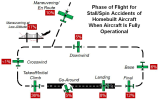I've often been surprised by how much things have changed just in the 20 years I've been flying..
Any other old f***s want to chime in?
..while not an old f*** yet.. or necessarily, sure why not, here's what I've seen

1. Was taught to fly all patterns so I could make the runway if the engine quits. No longer a factor, apparently.
-I was taught the same, as a CFI I teach the same as well. However our airport has a couple of the huge schools and I see them flying monster patterns. This makes it tough when I'm #2 following and the dude is on a 4 mile base.
-Why they do this?! I have no idea, it goes against what the PHAK and even the AIM suggest.. I think it's just sloppy flying by a lot of 250 hour CFIs who couldn't give a s*** and are desperate to hit their magical 1,500 hours
2. Power back to 2,000 when on downwind abeam the numbers, 1500 on base, idle on final. Nowadays they apparently have you play with the power through final.
-I teach 2200 and either 1500 or 1700 depending on the plane for downwind and base
-for final I got debriefed by both my most recent DPE practical (commercial and CFI, passed both first try) as this was not considered "stable" to be at idle.. fine. I sort of agree, but also don't. But to that point, I teach a "stable" approach but one that is virtually at idle..
3. I was taught to turn crosswind at 500'. CFIs on my BFRs seem to want me to climb to 800' or even TPA before turning.
-as was I.. however, I was recently corrected of this by our club's senior CFI group that the AIM 4-3-3 instructs turning crosswind 300' below TPA.. it's a nit pick, but that means at MYF I'm now turning crosswind at 1,100 instead of 900.. oddly enough I am often getting the "turn crosswind" from tower.. can't please everyone!
4. At uncontrolled fields, was taught to make radio calls on downwind and final. Now, they apparently want you to announce position on crosswind and base as well.
-I was taught to announce 10 miles out, and then in all 'key phases', IE, upwind, crosswind, downwind, final. It's kind of a lot of talking but we have a few 'very' busy untowered fields here with a lot of student traffic, so the extra call outs are likely not a bad idea
**Something you didn't mention, that I am finding now, there's a much higher level of CYA and fear of litigation. While 'yes' a CFI is responsible for his student, err, learner, we can't control every possible reaction from a human. But this means, personally, that I think at least a few pilots are spending more time before solo, and before licensure, unnecessarily. There's a difference to "can this person safely and legally fly to the practice area and land in the pattern" vs "can this person execute every maneuver to at least PPL ACS standards" - but I digress on that front!
How much was a conestoga wagon, shirt of chain mail, or ampule of Doc Harlan's Chilblain Serum then?



